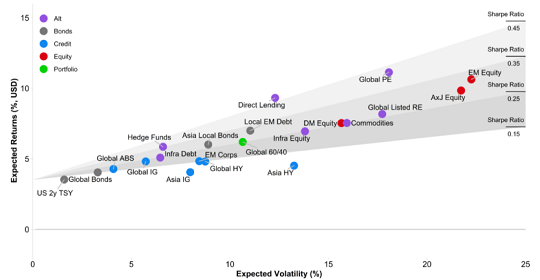Capital Market Assumptions
Key Highlights:
- A new era of geopolitical risks, tariffs, and policy uncertainty mean that supply shocks are back as a force on the economic machine. For long horizon investors, that means contending with more growth volatility and a stickier and spikier inflation.
- Our research into long-term expected returns reveals a re-ordering of risk payoffs across the asset class universe. It challenges the traditional textbook view of risk and reward and it could mean that investors need to recalibrate their assumptions. In particular, core US sovereign bonds are no longer seen as the world’s only safety asset class.
- Across the asset class spectrum, some areas continue to have high prospective returns and “anomalous” valuations – and emerging markets (EM) assets stand out. Weakness in the US dollar this year has been a key driver of that EM performance, and our analysis indicates investors can expect a continued, multi-year dollar decline. Some areas of private markets – especially private credits – also appear very attractive for long horizon investors.
HSBC AM Capital Market Line (10 year expected returns for selected assets)

Is US exceptionalism fading?
US Treasuries and the US dollar have traditionally been seen as “safety assets” by global investors. Likewise, the US stock market has long been regarded a pre-eminent source or dependable returns. Yet, rising government debt and more unpredictable policy has led to questions about the persistence of US exceptionalism. Treasuries no longer appear to be a “go-to” haven. The US dollar – which has historically tended to be strong in phases of both US outperformance and global risk-off episodes – has shown signs of faltering. And for US stocks, replicating the exceptional performance of the last 15 years could be a challenge unless Artificial Intelligence fully delivers on its productivity and profitability promises.
Where are the diversifiers in the world of fiscal dominance?
A world of fiscal dominance, supply shocks, de-globalisation, and high inflation has important implications for investors. Bond yields and risk premia are likely to be higher for longer, and yield curves are likely to be steeper. While this implies higher long-term expected returns, it could also mean a higher level of risk in asset classes that have traditionally been a source of protection for portfolios, such as government bonds. If conventional stock-bond allocations – like the classic 60/40 – begin to offer a less-certain risk-reward mix, investors will need safety substitutes. We argue that there are new options in non-US fixed income, in liquid alternatives or quantitative investment strategies, and in private markets.
Are we on the cusp of an EM bull market?
EMs appear to be entering a phase of structural opportunity that is being catalysed by the early stages of a long-term US dollar bear market. Historically, dollar cycles have averaged five to seven years, so the global tailwinds for EM may just be beginning. This bearish-dollar cycle stems from stretched risk asset valuations, large US twin deficits, and a trend of global investors diversifying away from dollar assets. In a nutshell, easier financial conditions and increased foreign investment flows are particularly favourable for EM assets.

